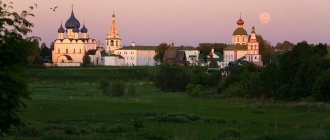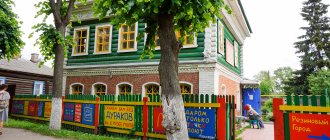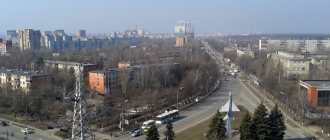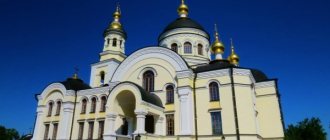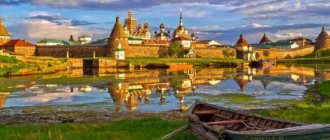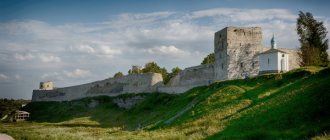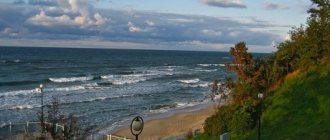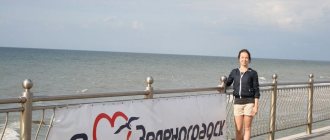Year of foundation: 1221
Nizhny Novgorod celebrates City Day on
the 3rd Saturday of August
.
In 2021,
this date is
August 21
.
In 2021, due to the pandemic, mass events in honor of the city day are canceled or may be postponed
Chkalov Stairs with the monument of the same name at the top
Nizhny Novgorod
- a Russian city, the center of the Volga Federal District, located along the banks of the Oka River, at its confluence with the Volga.
The city was founded by Prince Yuri Vsevolodovich in 1221
to protect Russian borders from Mordovians and Tatars.
In 1341, the city became the capital of the Suzdal-Nizhny Novgorod principality. In the 15th century, when the principality became part of the Moscow state, Nizhny Novgorod did not lose its importance as a guard fortress. Often, campaigns against the Kazan Khanate began from here. And only when Kazan was taken, the fortress of Nizhny Novgorod lost its relevance.
Nizhny Novgorod residents Kuzma Minin and Prince Dmitry Pozharsky led the militia in 1611 and in October 1612 liberated Moscow from Polish invaders.
In 1719 the city received provincial status. Since 1817, the Nizhny Novgorod Fair began to be held regularly, which soon gained all-Russian fame.
Monument to Minin and Pozharsky In 1917, Soviet power was established in the city, the Nizhny Novgorod province was abolished. In 1932, the city was renamed Gorky in honor of the writer Maxim Gorky and became the center of the Nizhny Novgorod region. The historical name was returned only in 1990.
In 1932, the Gorky Automobile Plant began operating, which during the Great Patriotic War became an important facility in the defense industry.
Modern Nizhny Novgorod continues the fair tradition, and is also one of the centers of the Russian IT industry.
By Decree of the President of the Russian Federation dated July 2, 2021, Nizhny Novgorod was awarded an honorary title for the significant contribution of city residents to achieving Victory in the Great Patriotic War of 1941–1945, ensuring uninterrupted production of military and civilian products at industrial enterprises, and demonstrating massive labor heroism and dedication. Russian Federation " City of Labor Valor"
».
Attractions
In the center of the city is the Nizhny Novgorod Kremlin, on the territory of which the St. Michael the Archangel Cathedral has been preserved. In addition, in the city you can see architectural monuments of the 18-19 centuries, examples of wooden architecture, and the medieval monasteries of Pechersky and Blagoveshchensky.
Nizhny Novgorod Kremlin
Interesting facts
The famous writer Maxim Gorky, inventor Ivan Kulibin and many other famous people were born in the city.
In the Chuvash language, Nizhny Novgorod in Chuvashia is called Chulkhula - “stone city”, and the Mari name of the city is Ugarman (“new fortress”).
The city's population is about 1.3 million people (as of 2021).
Day of the city
Previously it was celebrated in the fall, since 2014 its celebration was moved to June 12 and combined with the celebration of Russia Day, and since 2019 it was decided to celebrate it in August.
History of Nizhny Novgorod
The history of our city is so ancient and rich that many, from such an abundance of historical facts, can only remember the year of its foundation and the story about the Koromyslov Tower.
And, in fact, there is something to tell. It turns out that for many centuries before the construction of Nizhny Novgorod these lands belonged to the Mordovians and Tatars - Russians were never seen here. Only in the significant year 1221 did a small detachment of Russians settle here - and then only in order to “patrol their possessions.”
Without hesitation, Grand Duke Yuri Vsevolodovich, naming the new fortress, gave a name to the city and at the same time - topics for toponymic dissertations for dozens of descendants, because to this day there is no consensus on why “Nizhny”. Perhaps because it was located south of Veliky Novgorod, perhaps because it stood downstream of the Volga from ancient Gorodets, perhaps for some other reasons.
Having just been founded, with the domes of two brand new white stone churches soaring into the air, Nizhny was immediately destroyed by a Tatar raid. But it was immediately rebuilt, strengthening the earthen ramparts and strengthening military power. In general, the first two centuries for Nizhny were quite turbulent: it survived more than twenty Tatar raids, became the Orthodox center of the Volga region, served as the capital of the Nizhny Novgorod-Suzdal principality, feuded with Moscow and Tver for primacy, and even managed to establish a veche system for a short time.
And only at the end of the 15th century everything in Nizhny calmed down a little. He became the right hand of Moscow and “raised” the first stone Kremlin instead of earthen fortifications - through the efforts of Pyotr Fryazin (who, however, most likely had a completely different name - for he was from the non-Russian side, from overseas lands).
Having existed in this way, relatively calmly, for another two centuries, Nizhny again became the epicenter of events. In the winter of 1612, when Russian lands were invaded by Polish-Lithuanian invaders, in the central square of our city, Kozma Minin and Vsevolod Pozharsky gathered a people’s militia that liberated Rus'.
Having survived the Time of Troubles and the Seven Boyars, Nizhny blossomed wildly - industry, agriculture, and, thanks to the proximity of the Makaryevskaya Fair, trade developed. The second half of the 17th – 18th centuries became a “golden” time for Nizhny Novgorod: shipyards opened, crafts developed, and there was brisk trade with the East and South - through Kazan and Astrakhan.
In 1722, setting off on the Persian campaign, it was in Nizhny that Peter I celebrated his fiftieth birthday. With this highest “blessing,” the history of the rise of Nizhny Novgorod as an administrative center began - it became the capital of the Nizhny Novgorod Viceroyalty, which included the largest provinces of the Volga region. In the second half of the 18th century, hospitals and pharmacies opened here, one of the first public theaters in Russia appeared - the Shakhovsky Theater, as well as a printing house and a secular public school.
The beginning of the 19th century turned commercial and industrial Nizhny into a cultural center; the Nizhny Novgorod land produced more than one genius at that time: Kulibin, Lobachevsky, Ilyinsky, Damaskin - all of them were born in Nizhny Novgorod and took their first steps here.
The Nizhny Novgorod militia went through the entire war of 1812, just like two centuries ago, unanimously showing steadfastness and courage in the face of a foreign invader. And, having ended the war, the Nizhny Novgorod region rushed into the Decembrist unrest - Bestuzhev-Ryumin, Shakhovskoy, Muravyov, Belavin, Ulybyshev are associated with Nizhny. And even though their whole undertaking ended tragically, this fact itself once again confirms the importance of the Nizhny Novgorod region.
And finally, the culmination of the growth and development of Nizhny was the transfer of the Makaryevskaya Fair to Kunavino - this changed the appearance of the city and the way of life of its inhabitants once and for all: Nizhny was recognized as the third capital of Russia.
Having survived all the upheavals of the beginning of the century, the Nizhny Novgorod region blossomed as a cultural center: Korolenko, Dal, Chaliapin - their houses were open to anyone who was “open in soul to the muse.” At the same time, Karelin and Dmitriev, known for their first photographic photographs of the Nizhny Novgorod expanses, opened their own business. The city was actively being built - Varvarskaya, Pokrovskaya, Rozhdestvenskaya streets were built, Blagoveshchenskaya (Minin and Pozharsky) and Ostrozhnaya (Svobody) squares were reconstructed.
At the turn of the 19th and 20th centuries, Nizhny brought into the social and literary life of Russia a man whose name the city itself would later bear for eighty years - Maxim Gorky.
Also, at the beginning of the century, active construction of the industrial zone began - automobile and milling plants were opened, the Sormovo shipbuilding enterprise was reconstructed, and industry was actively developing.
During World War II, Nizhny became a stronghold of aircraft and mechanical engineering: GAZ during the war produced the same number of artillery pieces as were produced in total at all German enterprises. In the post-war period, Gorky was given the status of a “closed city,” which led to a delay in the development of the Nizhny Novgorod airport and tourist destination.
The end of Soviet power marked the return of Nizhny to its historical name. In the last twenty years, at the turn of the 20th and 21st centuries, many traditions lost in Soviet times have been restored: the Nizhny Novgorod Fair has started working again, ancient churches and monasteries have opened. Currently, the city is actively developing: new transport interchanges have appeared, active integrated development is underway, and new metro lines are being laid. Nizhny is making plans for the 2018 FIFA World Cup and is waiting for good changes.
Nizhny Novgorod in our time
There are 8 districts in Nizhny Novgorod: in the Nagorno part - Nizhny Novgorod, Sovetsky, Prioksky, in Zarechnaya - Kanavinsky, Avtozavodsky, Sormovsky, Moskovsky and Leninsky.
Parts of the city are connected by four bridges: Myzinsky, Molitovsky, Kanavinsky and Metromost. Myzinsky Bridge is the farthest from the city center, Kanavinsky is the closest and oldest. It connects the Nizhny Novgorod Fair, which is located on Lenin Square, with the central squares of Nizhny - Minin, Gorky and Lyadov.
The vast majority of attractions and historical monuments of Nizhny Novgorod are concentrated in the Nizhny Novgorod region. This is where the historical center of the city is located: in it you will find museums, clubs, the most fashionable cafes and art institutions, and an overwhelming number of universities. The historical center of the city coincides with the business center. In recent years, projects have been developed to free the historical center from office areas, but so far the situation has not changed one iota.
The central square is Minin and Pozharsky Square, where the main Nizhny Novgorod attraction is located - the Kremlin. By the way, an interesting fact: the main Nizhny Novgorod square is both the center of the city and its outskirts: it is located on the high bank of the Volga, and on the other side of the river another city begins - Bor. The central pedestrian street, Bolshaya Pokrovskaya, also begins from Minin Square.
City culture. At the moment, there are 7 theaters in Nizhny Novgorod, including the Youth Theater, the Drama Theater, the Comedy Theater, the Opera and Ballet Theater, as well as the Puppet and Chamber Musical Theaters. The city hosts theater and vocal festivals, and metropolitan groups tour monthly. The central sports ground of the city is the Nagorny Sports Palace, located on Gagarin Avenue, the central concert hall is the Jupiter Concert Hall. “Jupiter” has a capacity of 1000 seats and has a convenient location - on Varvarskaya Street, not far from Minin and Pozharsky Square.
Geographical location of Nizhny Novgorod
Nizhny Novgorod is located at the confluence of the Volga and Oka. At the same time, the Oka divides the city into two parts - an elevated, so-called “mountainous” part and a flatter part, beyond the river.
This difference in relief affects the air temperature, and therefore, as Nizhny Novgorod residents say, “below” can be several degrees warmer than “above”. The upper part of the city is more windy, the lower part is more humid.
In general, the weather in Nizhny Novgorod is no different from the weather in other cities in central Russia and is characterized by cold, snowy winters and moderately hot summers. But at the same time, compared to Moscow, in the summer in Nizhny it is somewhat hotter than in the capital, and in the winter it is a little colder.
Ethnographic composition
The population of Nizhny Novgorod is represented by a huge number of nationalities. There are more than 100 of them. The majority of the population in the city is Russian. There are 95 percent of them.
There are also Tatars, Mordovians, Armenians, Ukrainians, Azerbaijanis, Maris, Belarusians, Chuvashs, Jews and others. 0.12 percent of the population are Yazidis, who belong to the Kurdish ethnicity (Iraq).
Among other ethnic groups, the majority are Nizhny Novgorod Tatars. They make up 1.3 percent of the population.
The indigenous inhabitants of these lands - Erzyans and Mordovians (otherwise called Moksha) - there are only about 3,550 people in the city. This represents 0.28 percent of the city's population. Mostly indigenous small ethnic groups live in the region. These are Lukoyanovsky, Gaginsky, Shatkovsky districts in the south of the region.
Hotels in Nizhny Novgorod
In the capital of the Volga region there are many places where you can stay while visiting this interesting city.
It is worth noting that there is no 5* hotel in the city yet. However, the active development of the tourism industry, as well as major sporting and cultural events affecting Nizhny Novgorod, contribute to the fact that hotels appear here and there.
There is a four-star hotel in the immediate vicinity of the railway station, and on the road from the airport in the Avtozavodsky district of Nizhny Novgorod there is a high-quality three-ruble ruble. The remaining 3* hotels are located in the historical part of the city - Gorky, Ilyinsky streets and even literally at the foot of the Kremlin.
The trends of the times dictate their own rules, and in Nizhny Novgorod more and more mini-hotels with several rooms and hostels are appearing, characterized by an affordable pricing policy. They can be found in almost any corner of the city, which is undoubtedly convenient when planning your cultural or business program. On our website you can easily choose a hotel to suit every taste and budget, as well as read reviews about hotels in Nizhny Novgorod.
The stadium "Trud"
The largest ice arena in Nizhny Novgorod has already opened for public skating. They take place here on weekends in two sessions: from 15:30 to 17:30 and from 18:30 to 20:30. It is expected that the skating rink will operate in this mode until March. During the New Year holidays, from December 25 to January 9, public skating at the Trud stadium is planned every day. Passage of visitors here is carried out strictly using QR codes, although earlier the head of the Nizhny Novgorod Ministry of Culture Oleg Berkovich announced free access to all city skating rinks.
From January 2 to 8, visitors to the Trud stadium will enjoy Ilya Averbukh’s grandiose ice show “The Nutcracker.” The performance is based on the famous fairy tale by Ernst Theodor Hoffmann. The characters performed by the skaters will appear before the public in bright, luminous costumes.
This is a huge twenty-thousand-seat stadium. We allocate a sector for eight thousand people for the performance of the Nutcracker artists. The overall occupancy of the facility will be 60–70%. Again, this is a street and there is a large distance between people. I don’t see any problems from the point of view of COVID-19,” Oleg Berkovich emphasized.
Photo: Maria Nosyreva
Sights of Nizhny Novgorod
There is a lot to see in Nizhny. The wealth of the Nizhny Novgorod land is inexhaustible, although quantifiable - the Nizhny Novgorod Historical and Architectural Museum-Reserve has compiled a list of them. If you are planning to seriously study the history and culture of Nizhny Novgorod, study this list.
A complete list of Nizhny Novgorod attractions is a section for those who want to get to know each of them separately in more detail. For those for whom a brief overview will be sufficient, we will tell you briefly about them. So, being in Nizhny and not not visiting these attractions is at least a big omission.
Nizhny Novgorod Kremlin
The Nizhny Novgorod Kremlin is valuable both in itself - as the oldest surviving building, and also very picturesque. The oldest Nizhny Novgorod Cathedral, St. Michael the Archangel Cathedral, is also located in the same Kremlin.
It is in it that the ashes of the great Nizhny Novgorod resident Kozma Minin are buried. Also located in the Kremlin is the Art Museum, as well as two museums in the towers - Dmitrievskaya and Ivanovskaya. And, of course, here you will find the Eternal Flame, the stele of Minin and Pozharsky, as well as many other monuments.
Chkalov staircase
Next to it is a landmark that has long ago become one of the symbols of Nizhny - the Chkalov Stairs. Its height difference is three times greater than that of the famous Odessa Potemkinskaya, and its history is as ominous as it is fascinating.
Bolshaya Pokrovskaya
The central street of the city is the pedestrian Bolshaya Pokrovskaya, which deserves a separate walk - just looking at it would be a real blasphemy. Recently restored, it has not lost its charm and remains as rich in sights as it is in impressions. It starts on Lyadov Square and connects Gorky Square and Minin Square with its long road paved with red paving stones.
Sights associated with Maxim Gorky
And, if we are already talking about Gorky Square: for almost 80 years Nizhny Novgorod bore the name Gorky - in honor of Maxim Gorky. And, of course, we have many attractions associated with this name.
The main one is the house-museum “Kashirin’s House” (Pochtovyi Sezd, building 21). This is one of three branches of the Nizhny Novgorod State Museum of A.M. Gorky. The Kashirin House Museum is located in the house of Gorky’s grandfather, exactly what is described in the first part of the writer’s trilogy “Childhood. In people. My universities." The writer lived here in 1871 - 1872 and from here he went “into the people.” The museum preserves more than 150 things that directly belonged to the writer’s grandfather and grandmother - furnishings, utensils and clothing. Absolutely all rooms of the house are open to visitors.
The other two branches of the Nizhny Novgorod Gorky Museum are the Literary Museum (Minina St., 26), founded with the assistance of Gorky himself, and the Gorky Museum-Apartment (Semashko St., 19).
Museums
In general, we don’t have that many museums: a complete list of museums in Nizhny Novgorod. However, there are a few that are always interesting to visit.
Firstly, the classical museums: Pushkinsky (Minin and Pozharsky Square, 5) and Pokrovka-8 (Bolshaya Pokrovskaya St., 8). The Pushkin Museum will introduce you to exhibitions dedicated to Alexander Sergeevich’s stay in Nizhny Novgorod, and the Pokrovka-8 exhibition hall will introduce you to Sverdlov’s childhood and youth and the history of the city’s central street.
Another interesting museum is an open-air museum called “Museum of Architecture and Life of the Peoples of the Volga Region” (Shchelokovsky Farm, Gorbatovskaya St., 41). Now this museum, which is a fairly vast area occupied by wooden buildings of the 18th – 19th centuries, has fallen into some decline due to lack of funding.
However, it still preserves the spirit of peasant antiquity, and the diligent museum workers are always ready to take you on a fascinating tour of the houses and barns of the museum village.
Nizhny Novgorod Fair
Another symbol of Nizhny Novgorod is the Fair. It is located in the part beyond the river, on Lenin Square. Initially, in the 17th century, the fair was called Makaryevskaya and was located downstream of the Volga, near the town of Lyskovo.
Even then it was considered the largest in Russia. After the fire of 1816, it was moved to Nizhny and left across the river, connecting to the residential part of the city with a floating bridge. And then it finally blossomed. In 1929, however, it was closed with the wording “a socially hostile phenomenon.”
The Fair was restored to its status after perestroika, in 1991, and since then it has been one of the most famous exhibition complexes in Russia.
The buildings that you can now see at the Fair are exactly the same buildings built at the behest of Alexander I at the beginning of the 19th century. Of course, restored, but retaining their flavor.
The fair complex also includes two cathedrals - the Old Fair (Spassky) and the New Fair (Alexander Nevsky).
Moreover, the second one always appears on postcards with panoramas of Nizhny, taken from the observation deck on the Fedorovsky embankment. The usual: Kanavinsky Bridge - Strelka - port - Alexander Nevsky Cathedral.
Religious buildings
If we are already talking about churches, then we need to talk about other places of worship in the Nizhny Novgorod region - we have quite a lot of them, and all are stunningly beautiful.
Here, at least, is the Nativity Church on Rozhdestvenskaya Street. Its second name is Stroganovskaya, after the name of the merchant who gave money for construction. It was built at the end of the 17th century and is perfectly preserved: its scarlet walls and multi-colored domes still attract attention from afar. The interior decoration is also amazing. This is a functioning church, services and prayer services are held here.
Two of the most famous Nizhny Novgorod monasteries are also located within the city - Pechersky and Blagoveshchensky. The first, located near Sennaya Square, was founded here at the beginning of the 14th century by St. Dionysius and is known as the largest monastery in the Nizhny Novgorod region.
The second, also located on the high bank of the river, only at the Pokhvalinsky Congress, was founded even earlier - at the beginning of the 13th century. It was erected at the behest of the city’s founder, Yuri Vsevolodovich, and consecrated by Bishop Simeon of Vladimir.
The 20th century became the most difficult for the monastery - for more than 70 years, warehouses and office premises were located here, and the Alexievskaya Church of the monastery was preserved only due to the fact that it housed the Nizhny Novgorod Planetarium. In 1993, work began on the revival of the monastery, and when the Planetarium was moved to a new building in 2005, the monastery was completely restored. Under him, the Nizhny Novgorod Theological Seminary opened.
Nizhny Novgorod Circus and Planetarium
The modern Nizhny Novgorod Planetarium and Circus are another of our pride; these are attractions that are included in the list of 10 reasons to visit Nizhny Novgorod. The old circus was opened back in 1887 and worked for a hundred years until it was closed for reconstruction.
The reconstruction lasted more than twenty years, complicated by restructuring and a permanent lack of money. In 2007, the new circus was finally put into operation and immediately took a leading position among other Russian circuses. The same can be said about our Planetarium - it was the first in Russia equipped with a “digital planetarium” program and even surpassed many European planetariums in terms of technical equipment. The buildings of the Circus and the Planetarium are located next to each other in the trans-river part of the city, a ten-minute walk from the Moskovsky station towards the river.
Rozhdestvenskaya Street
Rozhdestvenskaya Street, by the way, is mentioned in our story about the sights of Nizhny not for the first time, and has not yet exhausted its excursion possibilities. It also houses the River Station with its museum of the Volga Shipping Company, and a cozy and cool public garden on Markov Square in the summer heat. This square, located in front of the River Station building, is also known for its foam fountain and the monument to the Heroes of the Volga Military Flotilla.
In 2012, as part of the “Christmas Side” project, the street reopened after reconstruction: the facades of historical buildings were restored, and a convenient pedestrian area with benches and lanterns was organized. In addition, this is the first historical street in Nizhny, on the most interesting objects of which QR codes are placed.
Monuments of Nizhny Novgorod
Of the monuments that deserve tourist attention, we can immediately name several of the most popular. In addition to the monuments to Chkalov (on Minin Square) and Gorky (on Gorky Square) already mentioned above, the monument to Minin and Pozharsky, erected at the Ivanovo Congress of the Nizhny Novgorod Kremlin, also deserves attention.
It is a small copy of the monument standing in Moscow near St. Basil's Cathedral. The Nizhny Novgorod monument, although not made by the hand of the great Tsereteli, still fits perfectly into the architectural ensemble of Skopa - now Appeal Square. Just like his older brother, the monument is installed against the backdrop of a church - in our case, the Cathedral of the Nativity of John the Baptist. According to historians, it was from the porch of this cathedral that Kozma Minin pronounced his famous call to the people of Nizhny Novgorod.
Zoos
For fauna lovers, there are two small but nice zoos in Nizhny - “Limpopo” in Sormovo (Yaroshenko, 7b) and “Switzerland” in the park of the same name on Gagarin Avenue. In the same park, by the way, there is the largest complex of stationary attractions in the city, which includes a large Ferris Wheel.
This, of course, is not a complete list of attractions in Nizhny Novgorod.
Boyhood
The onset of the 20th century was marked for Novgorod by troubled and difficult times for many years. The formation of Soviet power, the civil war and the First World War.
The Nizhny Novgorod pride and heritage of Russia - the fair - was banned. The wording used was “a phenomenon of a socially hostile nature.” The territories of the Nizhny Novgorod province were significantly abolished.
In the 1930s there was a rapid upsurge in the city's industry. The famous All-Union car production plant was built - GAZ, an aircraft plant, a fat plant, etc. The growth of industry gave impetus to the expansion of the population. The city boundaries were moved along the rivers.
It was the industrial significance of the city (at that time - the city of Gorky) that played a big role in the manifestation of aggressive close attention from the Nazi invader. Nizhny Novgorod was subjected to merciless bombing. This practically destroyed the city's infrastructure. Significant objects required rapid restoration. It was the priority of speed in this matter that played a bad joke in the future fate of Nizhny Novgorod.
At the end of the 50s, the city received the status of “closed” for many years, which was due to the large territorial concentration of the defense industry.
Historical justice was restored on October 22, 1990. The city was returned to its former name - Nizhny Novgorod. And at the same time, the possibility of restoring its former power and glory. For example, the Nizhny Novgorod Fair, known for centuries, was revived.
Walk through the center of Nizhny Novgorod
Gorky Square - Bolshaya Pokrovskaya Street - (optional: Student Bridge) - (optional: Fedorovsky Embankment) - (optional: Piskunova Street) - exhibition hall "Pokrovka-8" - Minin and Pozharsky Square - Singing Fountain - Kremlin - State Art Museum – Walk of Fame of the Great Patriotic War – St. Michael the Archangel Cathedral – Eternal Flame – Chkalov Stairs – Verkhnevolzhskaya Embankment
Most of Nizhny Novgorod's historical attractions are located in the city center. Thus, a fairly decent layer of Nizhny’s cultural heritage can be explored while moving on your own two feet.
So, you gathered your courage, put on comfortable shoes and set off to conquer the monuments and museums of the Nizhny Novgorod region. Where is the best place to start your journey?
And it will be most convenient for you to start your journey from Gorky Square: a walking route around Nizhny Novgorod.
Alexander Garden
Those who are tired of noisy fun will enjoy a quiet walk through the Alexander Garden. Although the location is not involved in the event program of the New Year's Capital of Russia 2022, it promises to become a truly atmospheric place. Decorators from the Nizhny Novgorod studio Dreamlaser are working on the lighting design of the space. With their light hand, architectural lighting on the trees will create the impression of real northern lights. The lighting effect of the illumination will enhance the visual and auditory elements.
Photo: Maria Nosyreva
Shopping and souvenirs in Nizhny Novgorod
Since Nizhny is the “philistine capital” (the third after “noble Moscow” and “intelligentsia St. Petersburg”), then it would be a sin to come to the city and not make a couple of purchases.
Large shopping centers where you can buy absolutely everything - from clothes and food to garden supplies - are located quite far from the center - Pechory, the Sormovsky and Moskovsky districts beyond the river, and even outside the city. There are large free buses and small paid gazelles that go to the outskirts, which are easily recognizable by the logo of the shopping center. A little closer are shopping centers on Belinskaya Street, Revolution Square and Lenin Avenue. A greater or lesser distance to the city center, however, this does not affect the price tags of stores - prices are approximately the same everywhere.
Boutiques of famous brands, in addition to shopping centers, can also be found on the main street and on some squares - Gorky, Lyadov, Svoboda. Don't look for TSUM in the central square - it's not there. Here it is located on Revolution Square near the Moscow Station and the Moscow Central Department Store very vaguely resembles it.
The most interesting shops of Bolshaya Pokrovskaya:
- "Dirigible" is a bookstore located on Pokrovskaya opposite the Oktyabr cinema.
- “First Bakery” - located to the left of the Kholodny Lane arch. This was indeed once the city's first bakery. And even earlier, in its place stood the Church of the Intercession of the Virgin Mary, the same one that gave its name to the entire street. Now it is a regular self-service store.
- DK Sverdlova. The former city assembly building is located near the tram tracks that cross the street. This place is an exhibition center and a store at the same time. Depending on the exhibition, you can admire exotic insects and birds or buy yourself a purebred kitten or an equally purebred fur coat at a reasonable price.
- "Artistic crafts." The store is located next to the Puppet Theater and is a huge center that has gathered under its roof handicrafts from all over the Nizhny Novgorod region. Here you will see and be able to purchase: Khokhloma and Pavlovsk paintings, Semyonov nesting dolls, clothes and linen with Gorodets embroidery, Chkalovsky guipure, forged crafts and knives from the Pavlovsk Metal Products Plant, Kazakovsky filigree, Varnavinsky crafts made of bone and much, much more. The land of Nizhny Novgorod is proud.
If you are interested in less expensive souvenirs, then, as befits all souvenirs, they are found in abundance in the center: in street stalls on the way from Gorky Square to Minin Square, as well as in the Kremlin - in the passage of the Dmitrievskaya Tower and in the souvenir shop of the Kladovaya Tower. Since the coat of arms of Nizhny Novgorod features a deer (which, by the way, has never been found in our forests), and the symbol of the Nizhny Novgorod region has been the Dmitrievskaya Tower of the Nizhny Novgorod Kremlin for more than one century, these are the ones you will most often see on souvenirs. The third popular scene is the view from the Kremlin or Fedorovsky embankment of the confluence of the Oka and Volga - Strelka.
